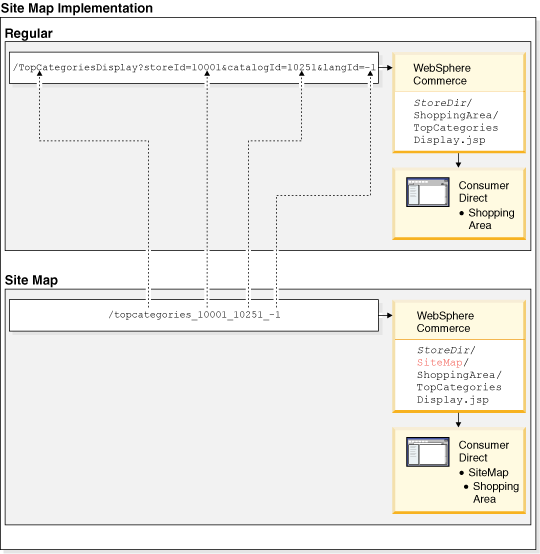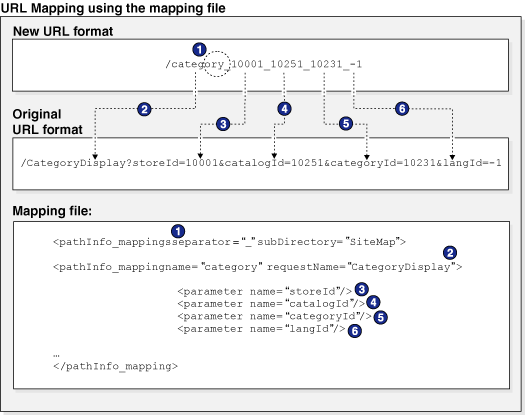Search engine optimization
Search engines, such as Google, are considered to be one of the most important channels for a site to reach new customers. To build a loyal customer base, the first step is to reach new customers and search engines provide an effective way to reach new customers.Dynamic, database-driven URLs, such as those generated by WebSphere Commerce, contain stop characters (?, &, and %) that can overwhelm search engine crawlers. For this reason, search engines limit the amount of dynamic URLs that they index. To overcome this limitation, WebSphere Commerce provides functionality to help improve the results of search engine indexing.
WebSphere Commerce's search engine optimization feature consists of the following functions:
- URL mapping that provides the ability to remove the stop characters by mapping WebSphere Commerce's dynamic URLs to static ones so that search engines can index the dynamic pages.
- Site map capability that provides an entry point for the search engine crawler to follow the links within your Web pages.
- Page content optimization that facilitates keyword modification so that the page is ranked high in search engine results. It provides the ability to modify words in the locations that are important for crawlers, by using the Product Management GUI, or by using the Change Pages GUI in WebSphere Commerce Accelerator.
We have provided the functionality to remove the inhibitors so that your Web pages can be indexed by search engines and to facilitate the optimization of page content. The ranking of your pages in the search results depends largely on how you optimize your pages.
URL Mapping
The URL mapping function allows Web pages to be accessed through a static looking URL by converting the URL from static to dynamic based on a mapping file:

For example, it can map the following static URL: webapp/wcs/stores/servlet/product_10001_10001_10032_-1
to the following dynamic WebSphere Commerce URL: webapp/wcs/stores/servlet/ProductDisplay?storeId=10001&catalogId=10001&productId=10032&langId=-1
Site Maps
A site map is used to address these two challenges:
- Changes to the site are not quickly reflected in the search engine indices.
- Most Web pages are designed for human visitors, not crawlers, and the design can reject crawlers due to an excessive number of graphics and large page size.
A site map helps to optimize the entire structure of the site for a crawler by providing an alternative set of Web pages built specifically for crawlers to quickly access and index a large number of embedded pages. Site maps facilitate deep searches of the site. A deep search is when a crawler visits and indexes pages that are deeply embedded within the site, for example, product pages that are lower in the hierarchy of the site. The following image shows how the site map function is implemented:

An effective site map is built as a high level overview of the different pages in the site and presents a large list of links to the crawler in as few pages as possible. For example, a site map starter page can list the top categories and the categories directly under the top categories (second level categories), or even third level categories. This reduces the number of clicks that it takes to get to any page on the site from the site map and also helps customers to navigate through the site, especially those customers with slower internet connections. As a result, it reduces the time that it takes for the content refresh to be reflected in the search engine. As new content and products are added to the site, the site map becomes the easiest way to bring this content forward to be indexed by crawlers.
The following image is an example of a site map starter page for a consumer direct starter store that contains links to the main category pages and their product pages.

Optimization of page content for search ranking
There are many different factors that search engines use to determine the ranking of pages. Search engines have crawlers that follow the links in a site's Web pages, collect the content from Web pages, and analyze the content by conducting sophisticated pattern matching.
When a search engine analyzes a page, some specific locations are given more weight than others. It is important to put appropriate keywords in these locations. Some of the locations that are ranked high in search results are:
- Page title
- The page title is the text that appears in a browser's title bar. The page title tag is an important consideration in how searches are ranked. Put the most commonly searched keywords in the title.
- Page heading
- The page heading is also an important place for keywords that are used by search engines.
- First sentence of the body
- Use words in the first sentence that describe the purpose of the page and attract visitors to click on this entry in the search results page.
WebSphere Commerce helps you optimize your page content by providing the Change Pages function and the Product Management tool to allow marketing personnel to update text in these locations.
Caching considerations
Dynamic URLs can take full advantage of caching. They can use either WebSphere dynamic caching at the Application Server, or edge caching, including the WebSphere ESI plug-in at the Web Server and the caching proxy in WebSphere Edge Components. Static URLs can only use WebSphere dynamic caching at the Application Server.
Related tasks
Optimizing your site for search engines
Tutorial: Adding dynamic text
Change a product
Updating page content